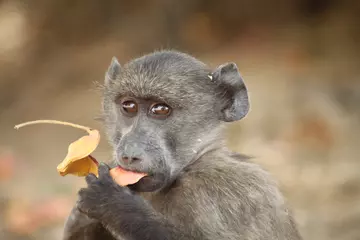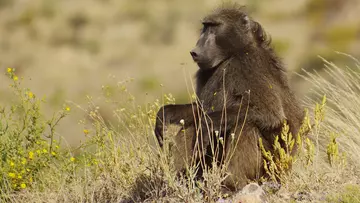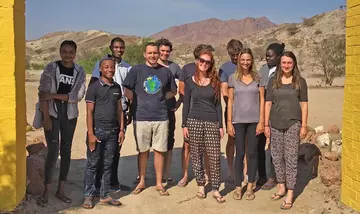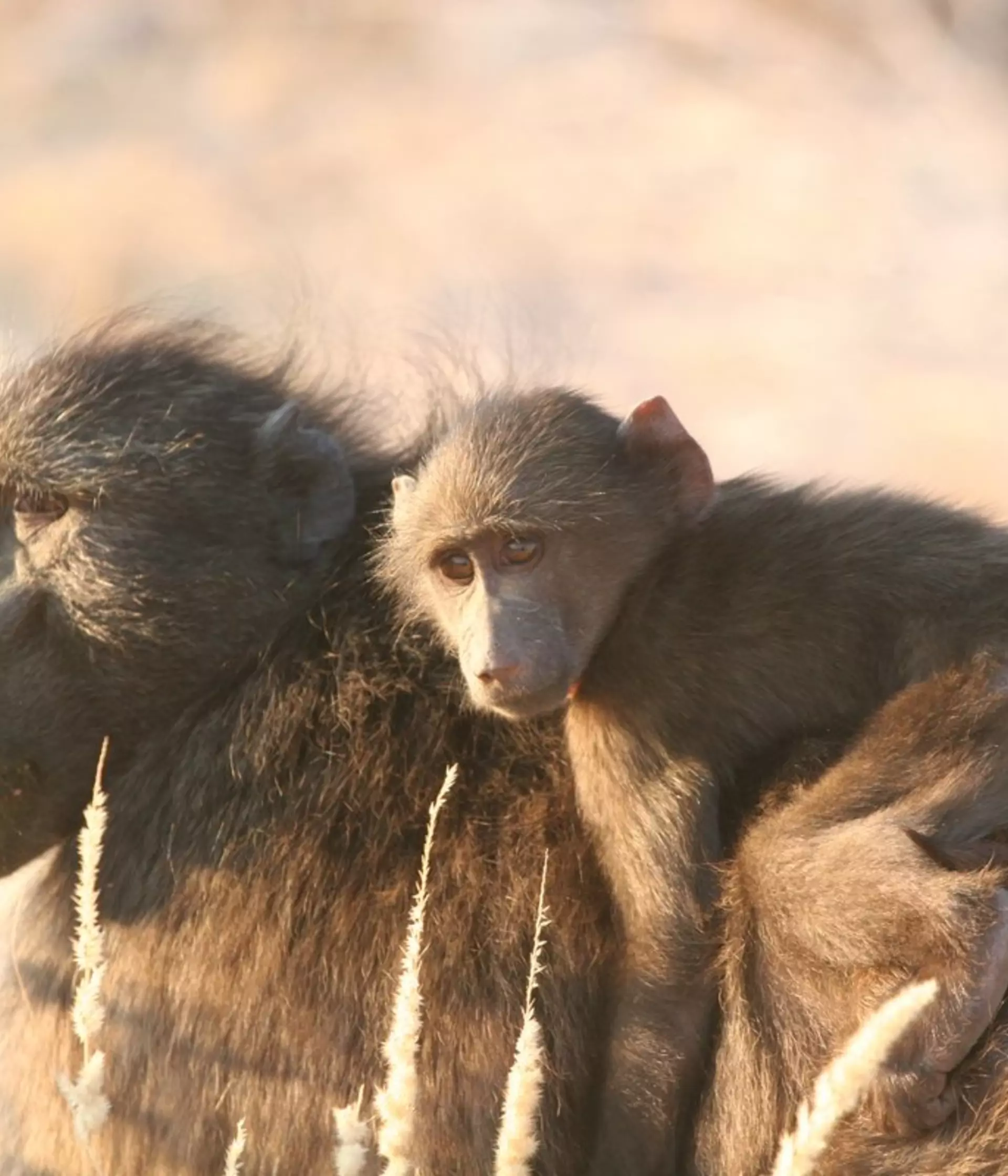
Prof. Guy Cowlishaw
Professor
A long-term study of the behaviour, life-history, ecology, genetics, and health of wild baboons
The Tsaobis Baboon Project explores the complex and fascinating lives of one of the world's most captivating social species, the chacma baboon. By understanding how baboons interact with each other and their environment, we hope to be better able to conserve social species more generally. The Tsaobis Baboon Project also runs an internship programme to provide training to the next generation of Namibian ecologists and conservation scientists.
Although the chacma baboon has been assessed by the IUCN as Least Concern, its numbers are decreasing, and the species is especially vulnerable to climate change (see research here).
People and partners
The Tsaobis Baboon Project is situated on the edge of the Namib Desert in central Namibia. Our work is hosted by Tsaobis Nature Park and carried out in affiliation with the Gobabeb Namib Research Institute. Research permission in Namibia is provided by the National Commission on Research, Science and Technology (NCRST) and the Ministry of Environment, Forestry and Tourism (MEFT).

The Tsaobis Baboon Project was established in 2000 at the Institute of Zoology, the research arm of ZSL. It is now run by three Project Directors as a collaboration across three international research institutions: Guy Cowlishaw at the Institute of Zoology, ZSL; Alecia Carter at the Department of Anthropology, University College London; and Elise Huchard at the Institute for Evolutionary Sciences, a mixed research unit from the University of Montpellier and French National Centre for Scientific Research (CNRS).

Research topics
Recent research projects on the Tsaobis baboons have asked:
- Do immigrants bring new knowledge into social groups, and how does that affect group behaviour? Find out the answer here.
- When should females give birth if the optimal birth timing for mothers and infants is different? Find out the answer here.
- Can mothers of low social rank sustain lactation for as long as mothers of high social rank? Find out the answer here.
- Do juvenile baboons inherit their social networks? Find out the answer here.
We also conduct research on the ecology and conservation of the wider desert environment. Research questions have included:
- What is causing tree dieback along the ephemeral Swakop River, and how might we best protect the remaining woodlands? Find out the answer here.
- How does the invasive mesquite tree affect native mammal communities? Find out the answer here.

2023
Delaunay A, Baniel A, Dezeure J, Carter AJ, Cowlishaw G, Charpentier MJE, Huchard E (2023) Transition to siblinghood in a wild chacma baboon population. Animal Behaviour 199: 123-139 · DOI 10.1016/j.anbehav.2023.02.011
Dezeure J, Burtschell L, Baniel A, Carter AJ, Godelle B, Cowlishaw G, Huchard E (2023) Evolutionary determinants of non-seasonal breeding in wild chacma baboons. American Naturalist 201: 106-124 · DOI 10.1086/722082
Mutti G, Oteo-Garcia G, Caldon M, Ferreira da Silva MJ, Minhós T, Cowlishaw G, Gottelli D, Huchard E, Carter A, Martinez FI, Raveane A, Capelli C (2023) Uncovering Y chromosome microsatellites with population genomic data: an assessment using Papio and Theropithecus genomes. Scientific Reports 13:13839 · DOI 10.1038/s41598-023-40931-x
Roatti V, Cowlishaw G, Huchard E, Carter A (2023) Social network inheritance and differentiation in wild baboons. RSOS 10: 230219 · DOI 10.1098/rsos.230219
2022
Carboni S, Dezeure J, Cowlishaw G, Huchard E, Marshall HH (2022) Stable isotopes reveal the effects of maternal rank and infant age on weaning dynamics in wild chacma baboons. Animal Behaviour 193: 21-32 · DOI 0.1016/j.anbehav.2022.08.010
Collet J, Pettorelli N, Baniel A, Carter AJ, Huchard E, King AJ, Lee AEG, Marshall HH, Cowlishaw G (2022) Immigrant males’ knowledge influences baboon troop movements to reduce home range overlap and mating competition. Behavioural Ecology 33: 398-407 · DOI 10.1093/beheco/arab145
2021
Baniel A, Webb C, Cowlishaw G, Huchard E. (2021) The submissive pattern of post-conflict affiliation in asymmetric relationships: a test in male and sexually coerced female baboons. Animal Behaviour 175: 87-97 · DOI 10.1016/j.anbehav.2021.02.014
Dezeure J, Baniel A, Carter AJ, Cowlishaw G, Godelle B, Huchard E. (2021) Birth timing generates reproductive trade-offs in a non-seasonal breeding primate. Proceedings of the Royal Society B 288: 20210286 · DOI 10.1098/rspb.2021.0286
Dezeure J, Dagorette J, Baniel A, Carter AJ, Cowlishaw G, Marshall HH, Martina C, Raby C, Huchard E. (2021) Developmental transitions in body color in chacma baboon infants: implications to estimate age and developmental pace. American Journal of Physical Anthropology 174: 89-102 · DOI 10.1002/ajpa.24118
Martina C, Cowlishaw G, Carter AJ. (2021) Individual differences in task participation in wild chacma baboons. Animal Behaviour 172: 73-91 · DOI 10.1016/j.anbehav.2020.11.020
Sankey D, O’Bryan L, Garnier S, Cowlishaw G, Hopkins P, Holton M, Fürtbauer I, King AJ. (2021) Consensus of travel direction is achieved by simple copying, not voting,in free-ranging goats. Royal Society Open Science 8: 201128 · DOI 10.1098/rsos.201128
2020
Carter AJ, Baniel A, Cowlishaw G, Huchard E. (2020) Baboon thanatology: responses of filial and non-filial group members to infants’ corpses. Royal Society Open Science 7: 192206 · DOI 10.1098/rsos.192206
Martina C, Cowlishaw G, Carter AJ. (2020) Exploring individual variation in associative learning abilities through an operant conditioning task in wild baboons. PLoS One 15: e0230810 ·DOI 10.1371/journal.pone.0230810
2019
Baniel A, Delauney A, Cowlishaw G, Huchard E (2019) Oestrous females avoid mating in front of adult male bystanders in wild chacma baboons. Royal Society Open Science 6: 181009 · DOI 10.1098/rsos.181009
O’Bryan L, Abaid N, Nakayama S, Dey T, King AJ, Cowlishaw G, Rubenstein D, Garnier S (2019) Contact calls facilitate group contraction in free-ranging goats (Capra aegagrus hircus). Frontiers in Ecology and Evolution 7: 73 · DOI 10.3389/fevo.2019.00073
Webb CE, Baniel A, Cowlishaw G, Huchard E (2019) Friend or foe: reconciliation between males and females in wild chacma baboons. Animal Behaviour 139: 37-49 · DOI 10.1016/j.anbehav.2018.03.001
2018
Baniel A, Cowlishaw G, Huchard E (2018) Jealous females? Female competition and reproductive suppression in a wild promiscuous primate. Proc. R. Soc. B 285: 20181332 · DOI 10.1098/rspb.2018.1332
Baniel A, Cowlishaw G, Huchard E (2018) Context-dependence of female reproductive competition in wild chacma baboons. Animal Behaviour 139: 37-49 · DOI 10.1016/j.anbehav.2018.03.001
Douglas CMS, Cowlishaw G, Henschel JR, Pettorelli N, Mulligan M (2018) Identifying the determinants of tree distributions along a large ephemeral river. Ecosphere 9: e02223 · DOI 10.1002/ecs2.2223
2017
Baniel A, Cowlishaw G, Huchard E (2017) Male violence and sexual intimidation in a wild primate society. Current Biology 27: 2163-2168 · DOI: 10.1016/j.cub.2017.06.013
Lee AEG, Cowlishaw G (2017) Switching spatial scale reveals dominance-dependent social foraging tactics in a wild primate. PeerJ 5:e3462 · DOI 10.7717/peerj.3462
2016
Baniel A, Cowlishaw G, Huchard E (2016) Stability and strength of male-female associations in a promiscuous primate society. Behav. Ecol. Sociobiol.70: 761-775 · DOI 10.1007/s00265-016-2100-8
Carter AJ, Ticó MT, Cowlishaw G (2016) Sequential phenotypic constraints on social information use. eLife 5: e13125 · DOI 10.7554/eLife.13125
Douglas CMS, Mulligan M, Henschel JR, Pettorelli N, Cowlishaw G (2016) Widespread dieback of riparian trees on a dammed ephemeral river and evidence of local mitigation by tributary flows. PeerJ 4: e2622 · DOI 10.7717/peerj.2622
Lee AEG, Ounsley JP, Coulson T, Rowcliffe JM, Cowlishaw G (2016) Information use and resource competition: an integrative framework. Proc. R. Soc. B 283: 20152550 · DOI10.1098/rspb.2015.2550
2015
Carter AJ,Lee AEG, Marshall HH, Tico MT, Cowlishaw G (2015) Phenotypic assortment in wild primate networks: implications for the dissemination of information. Royal Society Open Science 2: 140444 · DOI 10.1098/rsos.140444
Marshall HH, Carter AJ, Ashford A, Rowcliffe JMR, Cowlishaw G (2015) Social effects on foraging behaviour and success depend on local environmental conditions. Ecology and Evolution 5: 475-492 · DOI 10.1002/ece3.1377
2014
Carter AJ,Marshall HH, Heinsohn R, Cowlishaw G. (2014) Personality predicts the propensity for social learning in a wild social primate. PeerJ 2:e283; DOI 10.7717/peerj.283.
Castles M, Heinsohn R, Marshall HH, Lee A, Cowlishaw G, Carter AJ (2014) Social networks created with different techniques are not comparable. Animal Behaviour 96: 59-67.
Sick C, Carter AJ, Marshall HH, Knapp LA, Dabelsteen T, Cowlishaw G (2014) Evidence for varying social strategies across the day in chacma baboons. Biology Letters 10 20140249.
Williams D, Pettorelli N, Henschel J, Cowlishaw G, Douglas C (2014) Alien tree invasion and mammal distribution along an ephemeral river in Namibia. Journal of African Ecology 52: 404-413.
2013
Carter AJ, Feeney WE, Marshall HH, Cowlishaw G, Heinsohn R. (2013) Animal personality: what are behavioural ecologists measuring? Biological Reviews 88: 465-475.
Carter AJ, Marshall HH, Heinsohn R & Cowlishaw G. (2013) Personality only predicts decision-making when information is unreliable. Animal Behaviour 86: 633-639.
Huchard E, Charpentier MJ, Marshall H, King AJ, Knapp LA, Cowlishaw G. (2013) Paternal effects on access to resources in a promiscuous primate society. Behavioural Ecology 24: 229-236.
Marshall HH, Carter AJ, Ashford A, Rowcliffe JMR, Cowlishaw G. (2013) How do foragers decide when to leave a patch? A test of alternative models under natural and experimental conditions. Journal of Animal Ecology 82: 894-902.
Cowlishaw G (2013) Papio ursinus Chacma baboon. In: Mammals of Africa. Volume II: Primates (eds T. Butynski, J. Kingdon, J. Kalina), pp. 225-228. Bloomsbury: London.
2012
Benavides J, Huchard E, Pettorelli N, King AJ, Brown ME, Archer CE, Appleton CC, Raymond M, Cowlishaw G (2012) From parasite encounter to infection: multiple-scale drivers of parasite richness in a wild social primate. American Journal of Physical Anthropology 147: 52-63.
Carter AJ, Marshall HH, Heinsohn R, Cowlishaw G (2012a) Evaluating animal personalities: do observer assessments and experimental tests measure the same thing? Behavioural Ecology and Sociobiology 66: 153-60.
Carter AJ, Marshall HH, Heinsohn R, Cowlishaw G (2012b) How not to measure boldness: demonstration of a jingle fallacy in a wild social primate. Animal Behaviour 84 : 603-609
Marshall HH, Carter AJ, Coulson T, Rowcliffe JM, Cowlishaw G (2012). Exploring foraging decisions in a social primate using discrete-choice models.American Naturalist 180: 481-495.
Marshall HH, Carter AJ, Rowcliffe JM, Cowlishaw G. (2012) Linking social foraging behaviour with individual time budgets and emergent group-level phenomena. Animal Behaviour 84: 1295-1305.
Rands SA, Pettifor RA, Rowcliffe JM & Cowlishaw G (2012) State-dependent foraging rules for social animals in selfish herds. In Anil Seth, Tony Prescott & Joanna Bryson (eds) Modelling Natural Action Selection. Cambridge University Press: Cambridge. [reprinted from Proceedings B: Biological Sciences271: 2613-2620.]
2011
Huchard E, Cowlishaw G (2011) Female-female aggression around mating: an extra cost of sociality in a multimale primate society. Behavioural Ecology 22: 1003-1011.
King AJ, Clark FE, Cowlishaw G (2011) The dining etiquette of desert baboons: the roles of social bonds, kinship, and dominance in co-feeding networks. American Journal of Primatology 73: 768-774.
King AJ, Sueur C, Huchard E, Cowlishaw G (2011) A rule-of-thumb based on social affiliation explains collective movements in desert baboons. Animal Behaviour 82: 1337-1345.
Meise K, Keller C, Cowlishaw G, Fischer J (2011) Sources of acoustic variation: implications for production specificity and call categorization in chacma baboon (Papio ursinus) grunts. Journal of the Acoustical Society of America 129: 1631-1641.
2010
Célérier A, Huchard E, Alvergne A, Féjan D, Plard F, Cowlishaw G, Raymond M, Knapp LA & Bonadonna F (2010) Detective mice assess relatedness in baboons using olfactory cues. Journal of Experimental Biology 213: 1399-1405. [with commentary]
Huchard E, Alvergne A, Féjan D, Knapp LA, Cowlishaw G & Raymond M (2010) More than friends? Behavioural and genetic aspects of heterosexual associations in wild chacma baboons. Behavioural Ecology and Sociobiology 64: 769-781.
Huchard E, Knapp LA, Wang J, Raymond M & Cowlishaw G (2010) MHC, mate choice and heterozygote advantage in a wild social primate. Molecular Ecology 19: 2545-2561.
Huchard E, Raymond M, Benavides J, Marshall H, Knapp LA & Cowlishaw G (2010) A female signal reflects MHC genotype in a social primate. BMC Evolutionary Biology 10: 96.
Wang J, Brekke P, Huchard E, Knapp L, & Cowlishaw G (2010) Estimation of parameters of inbreeding and genetic drift in populations with overlapping generations. Evolution 64: 1704-1718.
2009
Alvergne A, Huchard E, Caillaud D, Charpentier MJE, Setchell JM, Ruppli C, Fejan D, Martinez L, Cowlishaw G & Raymond M (2009) Human ability to visually recognize kin within primates. International Journal of Primatology 30: 199-210.
Huchard E, Benavides J, Setchell J, Charpentier MJE, Alvergne A, King A, Knapp LA, Cowlishaw G & Raymond M (2009). The importance of shape in sexual signals: evidence from primate sexual swellings. Behavioural Ecology and Sociobiology 63: 1231-1242.
Huchard E, Courtiol A, Benavides J, Knapp LA, Raymond M & Cowlishaw G (2009) Can fertility signals lead to quality signals? Insights from the evolution of primate sexual swellings. Proceedings B: Biological Sciences 276: 1889-1897.
King AJ & Cowlishaw G (2009a) Feeding benefits drive interspecific associations between rock kestrels and desert baboons. Journal of Zoology 277: 111-118.
King AJ & Cowlishaw G (2009b) Leaders, followers, and group decision-making. Communicative and Integrative Biology 2: 2.
King AJ & Cowlishaw G (2009c) All together now: behavioural synchrony in baboons. Animal Behaviour 78: 1381-1387.
King AJ, Isaac NJB & Cowlishaw G (2009) Ecological, social, and reproductive factors shape producer-scrounger dynamics in baboons. Behavioral Ecology 20: 1039-1049.
Zinner d, Groeneveld LF, Keller C, Roos C (2009) Mitochondrial phylogeography of baboons (Papio spp.) – Indication for introgressive hybridization? BMC Evolutionary Biology 9:83.
2008
Huchard E, Weill M, Raymond M, Cowlishaw G & Knapp LA (2008) Polymorphism, haplotype composition, and selection in the Mhc-DRB of wild baboons.Immunogenetics 60: 585-598.
King AJ, Douglas C, Huchard E, Isaac N & Cowlishaw G (2008) Dominance and affiliation mediate despotism in a social primate. Current Biology 18: 1833-1838. [with commentary]
Rands SA, Cowlishaw G, Pettifor RA, Rowcliffe JM & Johnstone RA. (2008) The emergence of leaders and followers in foraging pairs when the qualities of individuals differ. BMC Evolutionary Biology 8: 51.
2006-2007
King A & Cowlishaw G (2007) When to use social information: the advantage of large group size in individual decision making. Biology Letters 3: 137-139.
Huchard E, Cowlishaw G, Raymond M, Weill M & Knapp LAP (2006) Molecular study of Mhc-DRB in wild chacma baboons reveals high variability and evidence for transpecies inheritance. Immunogenetics 58: 805-816.
Rands SA, Pettifor RA, Rowcliffe JM & Cowlishaw G (2006) Social foraging and dominance relationships: the effects of socially-mediated interference.Behavioural Ecology and Sociobiology 60: 572-581.
2000-2005
Cowlishaw G, Lawes MJ, Lightbody M, Martin A, Pettifor R & Rowcliffe JM (2004) A simple rule for the costs of vigilance: empirical evidence from a social forager. Proceedings B: Biological Sciences 271: 27-33. [related research on samango monkeys, Cercopithecus mitis erythrarcus]
Rands SA, Pettifor RA, Rowcliffe JM & Cowlishaw G (2004) State-dependent foraging rules for social animals in selfish herds. Proceedings B: Biological Sciences 271: 2613-2620.
Rands SA, Cowlishaw G, Pettifor RA, Rowcliffe JM & Johnstone RA (2003) The spontaneous emergence of leaders and followers in foraging groups.Nature 423: 432-434.
Hill RA & Cowlishaw G (2002) Foraging female baboons exhibit similar patterns of antipredator vigilance across two populations. In: Eat or be eaten: predation sensitive foraging in primates (ed LE Miller), pp.187-204. Cambridge University Press: Cambridge.
1997-1999
Cowlishaw G (1999) Ecological and social determinants of spacing behaviour in desert baboon groups. Behavioural Ecology and Sociobiology 45: 67-77.
Cowlishaw G (1998) The role of vigilance in the survival and reproductive strategies of desert baboons. Behaviour 135: 431-452.
Cowlishaw G (1997a) Trade-offs between foraging and predation risk determine habitat use in a desert baboon population. Animal Behaviour 53: 667-686.
Cowlishaw G (1997b) Refuge use and predation risk in a desert baboon population. Animal Behaviour 54: 241-253.
Cowlishaw G (1997c) Alarm calling and implications for risk perception in a desert baboon population. Ethology 103: 384-394.
Cowlishaw G & Davies JG (1997) Flora of the Pro-Namib Desert Swakop River Catchment: community classification and implications for desert vegetation sampling. Journal of Arid Environments 36: 271-290.
1994-1996
Cowlishaw G & O'Connell SM (1996) Male-male competition, paternity certainty and copulation calls in female baboons. Animal Behaviour 51: 235-238.
Davies JG & Cowlishaw G (1996) Interspecific competition between baboons and black kites following baboon-ungulate predation in the Namib desert. Journal of Arid Environments 34: 247-249.
Cowlishaw G (1995) Behavioural patterns during baboon group encounters: the role of resource competition and male reproductive strategies. Behaviour 132: 75-86.
O'Connell SM & Cowlishaw G (1995) The post-copulation withdrawal response in female baboons: a functional analysis. Primates 36: 441-446.
Cowlishaw G (1994) Vulnerability to predation in baboon populations. Behaviour 131: 293-304.
O'Connell SM & Cowlishaw G (1994) Infanticide avoidance, sperm competition and mate choice: the function of copulation calls in female baboons.Animal Behaviour 48: 687-694.
We regret that we are not recruiting any international volunteers to work with us on the Tsaobis Baboon Project in 2024. Positions for international volunteers may re-open in 2025 – please watch this space.

